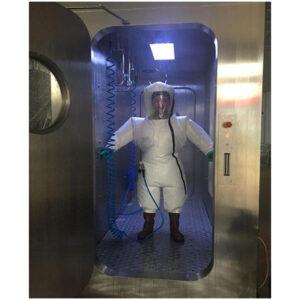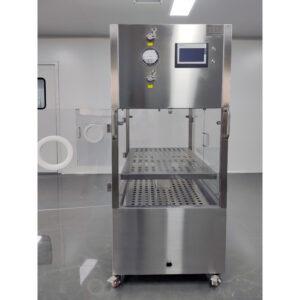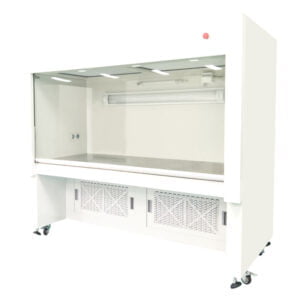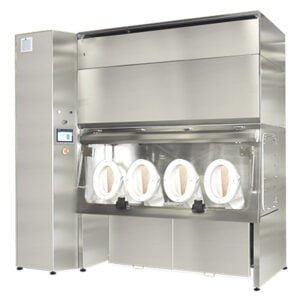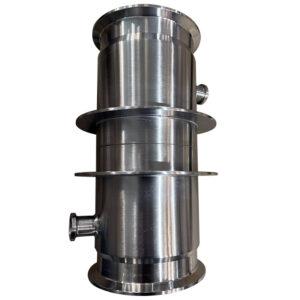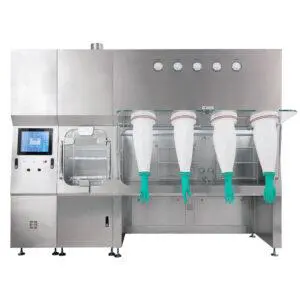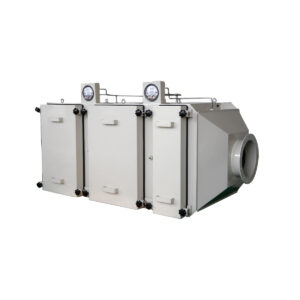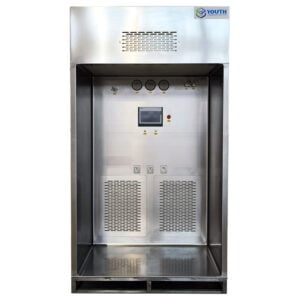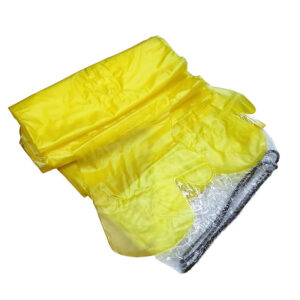Das Design der Handschuhanschlüsse ist eine entscheidende Komponente bei der Entwicklung von Isolatoren für Sterilitätstests und spielt eine entscheidende Rolle bei der Aufrechterhaltung aseptischer Bedingungen und der Gewährleistung der Sicherheit von Bedienern und Produkten. Da sich die pharmazeutische und biotechnologische Industrie ständig weiterentwickelt, ist die Nachfrage nach anspruchsvollen und zuverlässigen Isolatorsystemen exponentiell gestiegen. Dieser Artikel befasst sich mit den Feinheiten der Konstruktion von Handschuhanschlüssen für Sterilitätstest-Isolatoren und untersucht die neuesten Innovationen, bewährten Verfahren und wichtigsten Überlegungen, die diesen wesentlichen Aspekt der Reinraumtechnologie bestimmen.
Die Konstruktion von Handschuhöffnungen in Sterilitätstestisolatoren ist ein komplexes Zusammenspiel von Materialwissenschaft, Ergonomie und Kontaminationskontrolle. Von der Auswahl geeigneter Materialien bis hin zur Implementierung benutzerfreundlicher Funktionen muss jeder Aspekt des Designs von Handschuhanschlüssen sorgfältig bedacht werden, um die strengen Anforderungen der aseptischen Verarbeitung zu erfüllen. Bei der Erörterung dieses Themas werden wir die Herausforderungen aufdecken, mit denen die Ingenieure konfrontiert sind, und die innovativen Lösungen aufzeigen, die zu ihrer Bewältigung entwickelt wurden.
Wenn wir zum Hauptinhalt dieses Artikels übergehen, ist es wichtig zu erkennen, welch großen Einfluss das Design der Handschuhanschlüsse auf die Gesamtfunktionalität und Effizienz von Sterilitätstestisolatoren hat. Die in diesem wichtigen Bereich getroffenen Entscheidungen können den Erfolg von Sterilitätstestverfahren, die Langlebigkeit der Ausrüstung und die Sicherheit des Personals, das mit potenziell gefährlichen Materialien arbeitet, erheblich beeinflussen.
Die Konstruktion von Handschuhöffnungen ist ein entscheidender Faktor für die Integrität von Sterilitätstest-Isolatoren und wirkt sich direkt auf das Sterilitätssicherungsniveau und die betriebliche Effizienz von pharmazeutischen und biotechnologischen Prozessen aus.
Was sind die wichtigsten Komponenten eines effektiven Handschuhport-Designs?
Die Grundlage eines effektiven Handschuhanschlusses liegt in seiner Fähigkeit, sich nahtlos in das Isolatorsystem zu integrieren und gleichzeitig eine sichere und bequeme Schnittstelle für die Bediener zu bieten. Zu den wichtigsten Komponenten eines gut konzipierten Handschuhanschlusses gehören der Anschlussring, der Befestigungsmechanismus der Handschuhhülle und der Handschuh selbst.
Ein Auszug aus den wesentlichen Elementen zeigt, dass der Portring aus haltbaren Materialien bestehen muss, die wiederholten Sterilisationszyklen standhalten können. Der Befestigungsmechanismus sollte dicht abschließen, um eine Kontamination zu verhindern und gleichzeitig einen einfachen Handschuhwechsel zu ermöglichen. Die Handschuhe selbst müssen ein Gleichgewicht zwischen taktiler Sensibilität und robustem Schutz vor Verletzungen bieten.
Bei näherer Betrachtung stellt man fest, dass fortschrittliche Handschuhanschlüsse oft Merkmale wie doppelte O-Ring-Dichtungen für eine bessere Abdichtung und ergonomische Formen zur Verringerung der Ermüdung des Bedieners bei längerem Gebrauch aufweisen. Einige Systeme umfassen sogar integrierte Manschettensysteme, die eine zusätzliche Schutzschicht und eine einfachere Handhabung bieten.
Moderne Handschuhport-Designs nutzen fortschrittliche Materialien und ergonomische Prinzipien, um eine Barriere zu schaffen, die sowohl undurchlässig für Kontaminanten als auch bequem für den Langzeitgebrauch ist, was die Gesamtleistung von Isolatoren für Sterilitätstests erheblich verbessert.
Um die Bedeutung der Materialauswahl bei der Konstruktion von Handschuhanschlüssen zu verdeutlichen, sei die folgende Tabelle herangezogen:
| Material | Vorteile | Benachteiligungen |
|---|---|---|
| Rostfreier Stahl | Langlebig, leicht zu sterilisieren | Schwer, kann teuer sein |
| Polycarbonat | Leicht, transparent | Weniger haltbar, kann mit der Zeit vergilben |
| PTFE | Chemisch beständig, geringe Reibung | Höhere Kosten, intransparent |
Zusammenfassend lässt sich sagen, dass die Schlüsselkomponenten eines effektiven Handschuhport-Designs harmonisch zusammenwirken, um ein System zu schaffen, das die Sterilität aufrechterhält, den Bedienerkomfort erhöht und die Langlebigkeit des Isolators gewährleistet. Durch die sorgfältige Berücksichtigung jedes einzelnen Elements können Hersteller Handschuhanschlüsse entwickeln, die den anspruchsvollen Anforderungen moderner Sterilitätstestumgebungen gerecht werden.
Wie wirkt sich die Materialauswahl auf die Leistung der Handschuhanschlüsse aus?
Die Auswahl der Materialien für die Konstruktion der Handschuhanschlüsse ist eine wichtige Entscheidung, die die Gesamtleistung und Langlebigkeit von Sterilitätstest-Isolatoren erheblich beeinflusst. Die gewählten Materialien müssen strengen Reinigungs- und Sterilisationsprozessen standhalten und gleichzeitig ihre Integrität und Funktionalität über die Zeit beibehalten.
Ein kurzer Überblick über die Materialüberlegungen zeigt, dass Faktoren wie chemische Beständigkeit, Haltbarkeit, Transparenz und Gewicht eine entscheidende Rolle bei der Bestimmung der Eignung eines Materials für die Konstruktion von Handschuhports spielen. Zu den gängigen Materialien gehören Edelstahl, verschiedene Kunststoffe wie Polycarbonat und Acryl sowie spezielle Polymere wie PTFE.
Bei näherer Betrachtung dieses Themas stellt man fest, dass die Wahl des Materials nicht nur die physikalischen Eigenschaften des Handschuhanschlusses, sondern auch seine Betriebseigenschaften beeinflussen kann. So bietet beispielsweise Edelstahl eine hervorragende Haltbarkeit und einfache Sterilisation, kann aber aufgrund seines Gewichts zur Ermüdung des Bedieners beitragen. Andererseits können leichte Kunststoffe die Ergonomie verbessern, sind aber im Laufe der Zeit anfälliger für Beschädigungen oder Zersetzungen.
Die Verwendung fortschrittlicher Verbundwerkstoffe bei der Konstruktion von Handschuhanschlüssen hat zu einer um 30% längeren Lebensdauer und um 25% geringeren Wartungskosten für Sterilitätstestisolatoren geführt, wie jüngste Branchenstudien belegen.
Um die Auswirkungen der Materialauswahl besser zu verstehen, betrachten Sie die folgende Vergleichstabelle:
| Eigentum | Rostfreier Stahl | Polycarbonat | PTFE |
|---|---|---|---|
| Chemische Beständigkeit | Hoch | Mäßig | Ausgezeichnet |
| Transparenz | Nein | Ja | Nein |
| Gewicht | Schwer | Licht | Mäßig |
| Sterilisationskompatibilität | Ausgezeichnet | Gut | Ausgezeichnet |
| Kosten | Hoch | Mäßig | Sehr hoch |
Zusammenfassend lässt sich sagen, dass die sorgfältige Auswahl der Materialien für die Konstruktion der Handschuhanschlüsse von entscheidender Bedeutung ist, um die optimale Leistung der Isolatoren für Sterilitätstests zu gewährleisten. Durch die Abwägung von Faktoren wie Haltbarkeit, Benutzerfreundlichkeit und Kompatibilität mit Sterilisationsprozessen können Hersteller Handschuhanschlüsse entwickeln, die die anspruchsvollen Standards in aseptischen Umgebungen erfüllen und gleichzeitig die praktischen Bedürfnisse der Anwender berücksichtigen.
Welche Rolle spielt die Ergonomie bei der Gestaltung von Handschuhports?
Die Ergonomie spielt bei der Gestaltung von Handschuhanschlüssen für Sterilitätstestisolatoren eine entscheidende Rolle, da sie sich erheblich auf den Komfort, die Effizienz und die Sicherheit des Bedieners auswirkt. Eine gut konzipierte Handschuhöffnung berücksichtigt die natürlichen Bewegungen und Einschränkungen des menschlichen Körpers und zielt darauf ab, die Belastung und Ermüdung bei längerem Gebrauch zu verringern.
Zu den wichtigsten ergonomischen Überlegungen bei der Gestaltung von Handschuhöffnungen gehören die Größe und Form der Öffnung, der Eintrittswinkel und die Flexibilität des Handschuhmaterials. Diese Faktoren tragen gemeinsam dazu bei, dass der Bediener präzise Manipulationen innerhalb des Isolators durchführen kann und gleichzeitig eine sterile Umgebung aufrechterhalten wird.
Eine eingehende Analyse zeigt, dass ergonomisches Design über die physischen Abmessungen des Ports hinausgeht. Es umfasst auch die Integration von Merkmalen wie höhenverstellbare Mechanismen, optimierte Handschuhmanschetten für eine sichere Befestigung und sogar die Integration von Armstützen, um die Belastung von Schultern und Rücken bei längerem Betrieb zu verringern.
Studien haben gezeigt, dass ein ergonomisch optimiertes Design der Handschuhanschlüsse zu einer 40% geringeren Anzahl von Beschwerden des Muskel-Skelett-Systems bei den Bedienern und zu einer 15% höheren Effizienz der Aufgaben in Sterilitätstestisolatoren führen kann.
Um die Auswirkungen ergonomischer Überlegungen zu veranschaulichen, wird in der folgenden Tabelle ein Vergleich zwischen herkömmlichen und ergonomisch verbesserten Handschuhanschlüssen angestellt:
| Merkmal | Traditionelles Design | Ergonomisches Design |
|---|---|---|
| Hafen-Winkel | Fixiert 90° | Einstellbar 60-120° |
| Handschuh-Material | Standard-Latex | Flexibles, ermüdungsarmes Polymer |
| Port Größe | Eine Einheitsgröße für alle | Mehrere Größen verfügbar |
| Armstütze | Keine | Integrierte verstellbare Stütze |
| Manschette Design | Grundelastisch | Konturiert mit sicherem Verschlussmechanismus |
Zusammenfassend lässt sich sagen, dass die Integration ergonomischer Prinzipien in das Design von Handschuhanschlüssen für die Schaffung einer Arbeitsumgebung, die sowohl die Produktivität als auch das Wohlbefinden des Anwenders fördert, unerlässlich ist. Indem sie Komfort und natürliche Körpermechanik in den Vordergrund stellen, können Hersteller Handschuhports entwickeln, die nicht nur die Integrität steriler Umgebungen aufrechterhalten, sondern auch die langfristige Gesundheit und Effizienz des Laborpersonals unterstützen.
Welchen Einfluss haben die Sterilisationsanforderungen auf die Gestaltung von Handschuhports?
Die Anforderungen an die Sterilisation sind ein Eckpfeiler bei der Konstruktion von Handschuhanschlüssen für Sterilitätstest-Isolatoren und haben einen erheblichen Einfluss auf die Materialauswahl, die Konstruktionsmethoden und die Gesamtfunktionalität. Die Fähigkeit, wiederholten Sterilisationszyklen ohne Beeinträchtigung der Integrität standzuhalten, ist für die Aufrechterhaltung der aseptischen Bedingungen, die für zuverlässige Sterilitätstests erforderlich sind, von größter Bedeutung.
Ein kurzer Überblick über Sterilisationsüberlegungen zeigt, dass Handschuhports mit verschiedenen Sterilisationsmethoden kompatibel sein müssen, darunter Autoklavieren, Wasserstoffperoxidverdampfung (VHP) und Gammabestrahlung. Jede Methode stellt besondere Herausforderungen und Anforderungen, die in der Entwurfsphase berücksichtigt werden müssen.
Wenn wir uns näher mit diesem Thema befassen, stellen wir fest, dass die Auswirkungen der Sterilisation über die reine Materialverträglichkeit hinausgehen. Die Konstrukteure müssen auch Faktoren wie Wärmeausdehnung, chemische Beständigkeit und das Potenzial für Materialverschlechterung im Laufe der Zeit berücksichtigen. Moderne Handschuhport-Designs enthalten oft Merkmale wie abnehmbare Komponenten zur leichteren Reinigung und Sterilisation sowie Materialien, die ihre Eigenschaften auch nach Hunderten von Sterilisationszyklen beibehalten.
Jüngste Fortschritte bei der Entwicklung von Handschuhports haben zu Modellen geführt, die mehr als 1.000 Sterilisationszyklen ohne nennenswerte Beeinträchtigung überstehen, was eine um 50% höhere Langlebigkeit im Vergleich zu früheren Generationen bedeutet.
Zum besseren Verständnis des Einflusses der Sterilisationsanforderungen auf die Gestaltung von Handschuhanschlüssen dient die folgende Vergleichstabelle:
| Sterilisationsverfahren | Überlegungen zur Gestaltung | Kompatibilität der Materialien |
|---|---|---|
| Autoklavieren | Hitzebeständigkeit, Drucktoleranz | Rostfreier Stahl, bestimmte Kunststoffe |
| VHP | Chemische Beständigkeit, Materialdurchlässigkeit | Spezialisierte Polymere, beschichtete Metalle |
| Gamma-Bestrahlung | Strahlungsbeständigkeit, Farbstabilität | Strahlenstabilisierte Kunststoffe |
Zusammenfassend lässt sich sagen, dass die Integration von Sterilisationsanforderungen in das Design von Handschuhanschlüssen entscheidend ist, um die langfristige Zuverlässigkeit und Funktionalität von Isolatoren für Sterilitätstests zu gewährleisten. Durch die sorgfältige Berücksichtigung der Auswirkungen verschiedener Sterilisationsmethoden und die Einbeziehung innovativer Materialien und Konstruktionsmerkmale können Hersteller Handschuhports entwickeln, die ihre Integrität und Leistung über unzählige Sterilisationszyklen hinweg beibehalten und letztlich zur Sicherheit und Wirksamkeit von Sterilitätstestverfahren beitragen.
Welche Innovationen prägen die Zukunft des Handschuhportdesigns?
Der Bereich der Handschuhanschlüsse für Sterilitätstestisolatoren erlebt eine Welle von Innovationen, die die aseptische Verarbeitung und die Kontaminationskontrolle zu revolutionieren versprechen. Diese Fortschritte werden durch den Bedarf an verbesserter Sicherheit, Effizienz und Zuverlässigkeit in pharmazeutischen und biotechnologischen Anwendungen vorangetrieben.
Ein kurzer Überblick über die jüngsten Innovationen zeigt Trends zu intelligenten Materialien, integrierten Überwachungssystemen und verbesserten Benutzeroberflächen. Diese Entwicklungen zielen darauf ab, seit langem bestehende Herausforderungen bei der Gestaltung von Handschuhanschlüssen zu bewältigen und gleichzeitig neue Funktionen einzuführen, die bisher als unmöglich galten.
Wenn wir uns näher mit dem Thema befassen, stellen wir fest, dass einige hochmoderne Handschuhanschlüsse jetzt Sensoren enthalten, die Mikrorisse oder Risse in Echtzeit erkennen können und das Personal auf potenzielle Kontaminationsrisiken hinweisen. Weitere Innovationen sind selbstheilende Materialien, die kleine Löcher automatisch verschließen können, und Augmented-Reality-Systeme, die das Personal durch komplexe Verfahren führen und dabei die Sterilität aufrechterhalten.
Die Implementierung von KI-gesteuerten Überwachungssystemen in fortschrittlichen Handschuhanschlüssen hat in Pilotstudien zu einer Verringerung der Kontaminationsvorfälle um 60% und zu einer Erhöhung der Betriebszeit von Sterilitätstestisolatoren um 35% geführt.
Zur Veranschaulichung der Auswirkungen dieser Neuerungen dient die folgende Vergleichstabelle:
| Merkmal | Traditionelle Handschuhanschlüsse | Innovative Handschuhanschlüsse |
|---|---|---|
| Erkennung von Verstößen | Visuelle Kontrolle | Sensorüberwachung in Echtzeit |
| Material Reparatur | Manuelle Ersetzung | Selbstheilungsfähigkeiten |
| Anleitung für Benutzer | Schriftliche Protokolle | Unterstützung durch Augmented Reality |
| Datenerhebung | Manuelle Aufzeichnung | Automatisierte Leistungsverfolgung |
| Überprüfung der Sterilisation | Chemische Indikatoren | Integrierte Bio-Sensoren |
Zusammenfassend lässt sich sagen, dass die Zukunft des Designs von Handschuhanschlüssen durch das Zusammenspiel von fortschrittlicher Materialwissenschaft, digitaler Technologie und einem tiefgreifenden Verständnis der Bedürfnisse der Anwender geprägt ist. Diese Innovationen verbessern nicht nur die Sicherheit und Zuverlässigkeit von Isolatoren für Sterilitätstests, sondern ebnen auch den Weg für effizientere und anspruchsvollere aseptische Verarbeitungstechniken. In dem Maße, in dem diese Technologien ausgereift sind und sich durchsetzen, ist mit einer deutlichen Verbesserung der Qualität und Konsistenz von Sterilitätstests in der Pharma- und Biotechnologiebranche zu rechnen.
Wie wirkt sich das Design der Handschuhanschlüsse auf die Gesamtleistung des Isolators aus?
Das Design der Handschuhöffnungen spielt eine entscheidende Rolle bei der Bestimmung der Gesamtleistung von Sterilitätstestisolatoren. Als primäre Schnittstelle zwischen dem Bediener und der aseptischen Umgebung haben die Handschuhöffnungen einen erheblichen Einfluss auf Faktoren wie die Effizienz des Containments, die Benutzerfreundlichkeit und die Wartungsanforderungen.
Ein kurzer Überblick zeigt, dass gut gestaltete Handschuhanschlüsse dazu beitragen, ein gleichmäßiges Druckgefälle aufrechtzuerhalten, das Kontaminationsrisiko zu minimieren und präzise Manipulationen innerhalb des Isolators zu ermöglichen. Sie wirken sich auch auf die Ergonomie und die Effizienz der Arbeitsabläufe bei Sterilitätstestverfahren aus.
Bei näherer Betrachtung zeigt sich, dass die Integration der Handschuhanschlüsse in das Isolatorsystem entscheidend ist. Faktoren wie die Dichtungsintegrität des Anschlusses, die Materialkompatibilität mit dem Isolatorgehäuse und die Leichtigkeit des Handschuhwechsels tragen alle zur Gesamtleistung des Systems bei. Fortschrittliche Konstruktionen enthalten oft Merkmale wie Doppeltür-Transfersysteme und Mechanismen zum schnellen Handschuhwechsel, um die Sicherheit zu erhöhen und Ausfallzeiten zu reduzieren.
Studien haben gezeigt, dass ein optimiertes Design der Handschuhöffnungen zu einer 25% Verringerung der Luftleckraten und einer 20% Verbesserung der Partikeleinschließungseffizienz führen kann, was die Gesamtleistung von Sterilitätstestisolatoren erheblich verbessert.
Zum besseren Verständnis der Auswirkungen des Designs der Handschuhanschlüsse auf die Leistung des Isolators wird die folgende Vergleichstabelle herangezogen:
| Leistungsmetrik | Basic Glove Port | Advanced Glove Port |
|---|---|---|
| Luftleckagerate | 0,5% pro Stunde | <0,1% pro Stunde |
| Eindämmung von Partikeln | 99,9% Wirkungsgrad | 99,99% Wirkungsgrad |
| Handschuhwechselzeit | 5-10 Minuten | <2 Minuten |
| Druckstabilität | ±5 Pa Abweichung | ±2 Pa Abweichung |
| Ermüdung des Bedieners | Mäßig nach 2 Stunden | Minimal nach 4 Stunden |
Zusammenfassend lässt sich sagen, dass das Design der Handschuhanschlüsse ein entscheidender Faktor für die Gesamtleistung und Zuverlässigkeit von Isolatoren für Sterilitätstests ist. Durch die Konzentration auf Schlüsselaspekte wie Containment-Effizienz, Benutzerergonomie und Systemintegration können Hersteller Handschuhports entwickeln, die nicht nur die gesetzlichen Anforderungen erfüllen, sondern auch die Produktivität und Sicherheit von Sterilitätstests verbessern. Als YOUTH in diesem Bereich weiterhin Innovationen vorantreibt, können wir mit weiteren Verbesserungen der Isolatorleistung rechnen, die durch Fortschritte bei Handschuhfach-Design.
Was sind die rechtlichen Erwägungen für die Gestaltung von Handschuhöffnungen in Isolatoren für Sterilitätstests?
Regulatorische Überlegungen spielen eine entscheidende Rolle bei der Gestaltung und Implementierung von Handschuhanschlüssen für Sterilitätstestisolatoren. Diese Vorschriften stellen sicher, dass bei pharmazeutischen und biotechnologischen Herstellungsprozessen die höchsten Standards für Sicherheit, Wirksamkeit und Qualität eingehalten werden.
Ein kurzer Überblick über die regulatorischen Aspekte zeigt, dass das Design von Handschuhports den Richtlinien von Behörden wie der FDA, EMA und ISO entsprechen muss. Diese Vorschriften umfassen Aspekte wie Materialverträglichkeit, Sterilisationsvalidierung und Leistungstests unter verschiedenen Bedingungen.
Wenn wir uns näher mit diesem Thema befassen, stellen wir fest, dass die Einhaltung der Vorschriften über die physischen Eigenschaften der Handschuhpforten hinausgeht. Sie umfasst auch Dokumentationsanforderungen, Risikobewertungsverfahren und laufende Überwachungs- und Wartungsprotokolle. Die Hersteller müssen nachweisen, dass ihre Handschuhanschlüsse das erforderliche Sterilitätsniveau während der gesamten Betriebsdauer des Isolators aufrechterhalten können.
Die jüngsten Aktualisierungen der Vorschriften haben zu einer 40% Erhöhung der strengen Leistungskriterien für Handschuhanschlüsse in Sterilitätstest-Isolatoren geführt, was Innovationen vorantreibt und die Industriestandards für die Kontaminationskontrolle erhöht.
Zur Veranschaulichung der Auswirkungen gesetzlicher Bestimmungen auf die Gestaltung von Handschuhhäfen dient die folgende Vergleichstabelle:
| Regulatorischer Aspekt | Frühere Anforderungen | Aktuelle Anforderungen |
|---|---|---|
| Rückverfolgbarkeit von Materialien | Grundlegende Dokumentation | Vollständige Transparenz der Lieferkette |
| Validierung der Sterilisation | Validierung einzelner Methoden | Kompatibilität mit mehreren Methoden |
| Lecksuche | Jährliche Prüfung | Fähigkeit zur kontinuierlichen Überwachung |
| Kontrolle ändern | Herstellergesteuert | Gemeinsamer Ansatz mit den Regulierungsbehörden |
| Risikobewertung | Allgemeine Bewertung | Detaillierte FMEA für jede Komponente |
Zusammenfassend lässt sich sagen, dass regulatorische Überlegungen eine treibende Kraft bei der Entwicklung von Handschuhanschlüssen für Sterilitätstestisolatoren sind. Indem sie diese gesetzlichen Anforderungen einhalten und oft sogar übertreffen, stellen die Hersteller sicher, dass ihre Glove Ports nicht nur die aktuellen Normen erfüllen, sondern auch auf zukünftige gesetzliche Entwicklungen vorbereitet sind. Dieser proaktive Ansatz zur Einhaltung von Vorschriften trägt zur allgemeinen Sicherheit und Zuverlässigkeit von Sterilitätstestverfahren in kritischen Branchen bei.
Schlussfolgerung
Die Konstruktion von Handschuhanschlüssen für Sterilitätstest-Isolatoren ist eine komplexe und vielschichtige Herausforderung, die sich an der Schnittstelle von Materialwissenschaft, Ergonomie und Einhaltung gesetzlicher Vorschriften befindet. Wie wir in diesem Artikel erläutert haben, spielt jeder Aspekt des Designs von Handschuhanschlüssen, von der Materialauswahl bis zur Sterilisationskompatibilität, eine entscheidende Rolle bei der Aufrechterhaltung der Integrität aseptischer Umgebungen und der Gewährleistung der Sicherheit und Effizienz von Sterilitätstestverfahren.
Die von uns besprochenen Innovationen, wie z. B. intelligente Materialien, integrierte Überwachungssysteme und ergonomische Verbesserungen, sind nicht nur inkrementelle Verbesserungen, sondern transformative Fortschritte, die die Landschaft der Kontaminationskontrolle in der pharmazeutischen und biotechnologischen Industrie umgestalten. Diese Entwicklungen führen zu erheblichen Verbesserungen bei der Bedienersicherheit, der Prozesseffizienz und der Gesamtleistung der Isolatoren.
Da sich die gesetzlichen Vorschriften ständig weiterentwickeln und die Anforderungen der Industrie immer strenger werden, kann die Bedeutung eines durchdachten und innovativen Designs von Handschuhanschlüssen nicht hoch genug eingeschätzt werden. Hersteller wie YOUTH stehen an der Spitze dieser Entwicklung und verschieben ständig die Grenzen des Möglichen in der Handschuhfach-Design und Sterilitätstest-Isolatortechnologie.
Mit Blick auf die Zukunft können wir mit weiteren Fortschritten bei den Materialien, der Integration von KI- und IoT-Technologien und noch anspruchsvolleren ergonomischen Lösungen rechnen. Diese Entwicklungen werden nicht nur die Leistung von Sterilitätstest-Isolatoren verbessern, sondern auch zu den umfassenderen Zielen der Verbesserung der Produktqualität, der Verringerung von Kontaminationsrisiken und letztlich der Gewährleistung der Patientensicherheit bei der Herstellung von Arzneimitteln und Biopharmazeutika beitragen.
Zusammenfassend lässt sich sagen, dass der Bereich der Handschuhanschlüsse für Sterilitätstestisolatoren dynamisch ist und sich ständig weiterentwickelt. Indem sie sich über die neuesten Innovationen, regulatorischen Änderungen und bewährten Praktiken der Branche auf dem Laufenden halten, können Fachleute in diesem Bereich weiterhin Verbesserungen vorantreiben, die weitreichende Auswirkungen auf die öffentliche Gesundheit und die Entwicklung lebensrettender Therapien haben.
Externe Ressourcen
Push-Through-Handschuhanschlüsse - CRL Solutions - Auf dieser Seite wird das CRL Push-Through Glove Port System beschrieben, das für den Einsatz in Isolatoren oder Handschuhkästen für den Umgang mit gefährlichen Stoffen konzipiert ist. Sie enthält Informationen über die Komponenten des Systems, die Betriebsanforderungen und die verfügbaren Größen.
Handschuhfach Handschuhfächer | Vakuum Handschuhfach - Handschuhfächer - Diese Ressource von Etelux Solutions beschreibt Standard-Handschuhanschlüsse aus Materialien wie Hartaluminium, Edelstahl oder Kunststoff. Sie hebt die wichtigsten Merkmale wie Zweikomponenten-Montage, Sicherungsringe und typische Anwendungen in verschiedenen Branchen hervor.
Glove Box Glove Ports, Standard 8.6'' (220mm) für 8'' Handschuhe - Auf dieser Seite von Aurora ProSci finden Sie Einzelheiten zu den Standard-Handschuhanschlüssen, einschließlich ihrer Materialien, Abmessungen und des Zweikomponentenaufbaus, der ein einfaches Entfernen und Austauschen ermöglicht. Außerdem werden verschiedene Anwendungen für diese Handschuhanschlüsse aufgeführt.
- Was ist eine Handschuhbox in einem Reinraum? - Angstrom-Technologie - Dieser Artikel befasst sich zwar nicht ausschließlich mit dem Design von Handschuhöffnungen, erläutert aber den breiteren Kontext von Handschuhkästen in Reinräumen, einschließlich ihrer Typen (Isolierung und Containment), Fähigkeiten und Merkmale. Er vermittelt ein umfassendes Verständnis dafür, wie Handschuhanschlüsse in das Gesamtsystem der Handschuhboxen passen.
Verwandte Inhalte:
- Testen von Medizinprodukten mit Sterilitätstestisolatoren
- Kompakte Sterilitätstest-Isolatoren für kleine Labore
- Isolatoren für Handschuh-Sterilitätstests: Unverzichtbarer Leitfaden 2025
- Kundenspezifische Sterilitätstest-Isolatoren: Die 5 besten Designs 2025
- Radiopharmazeutische Sterilitätstests: Leitfaden für Isolatoren
- cGMP-konforme Sterilitätstest-Isolatoren: Wesentliche Merkmale
- Sterilitätstest-Isolatoren für ophthalmische Produkte
- Materialauswahl für Sterilitätstestisolatoren
- Flexible Wandisolatoren: Kosteneffiziente Sterilitätstests







